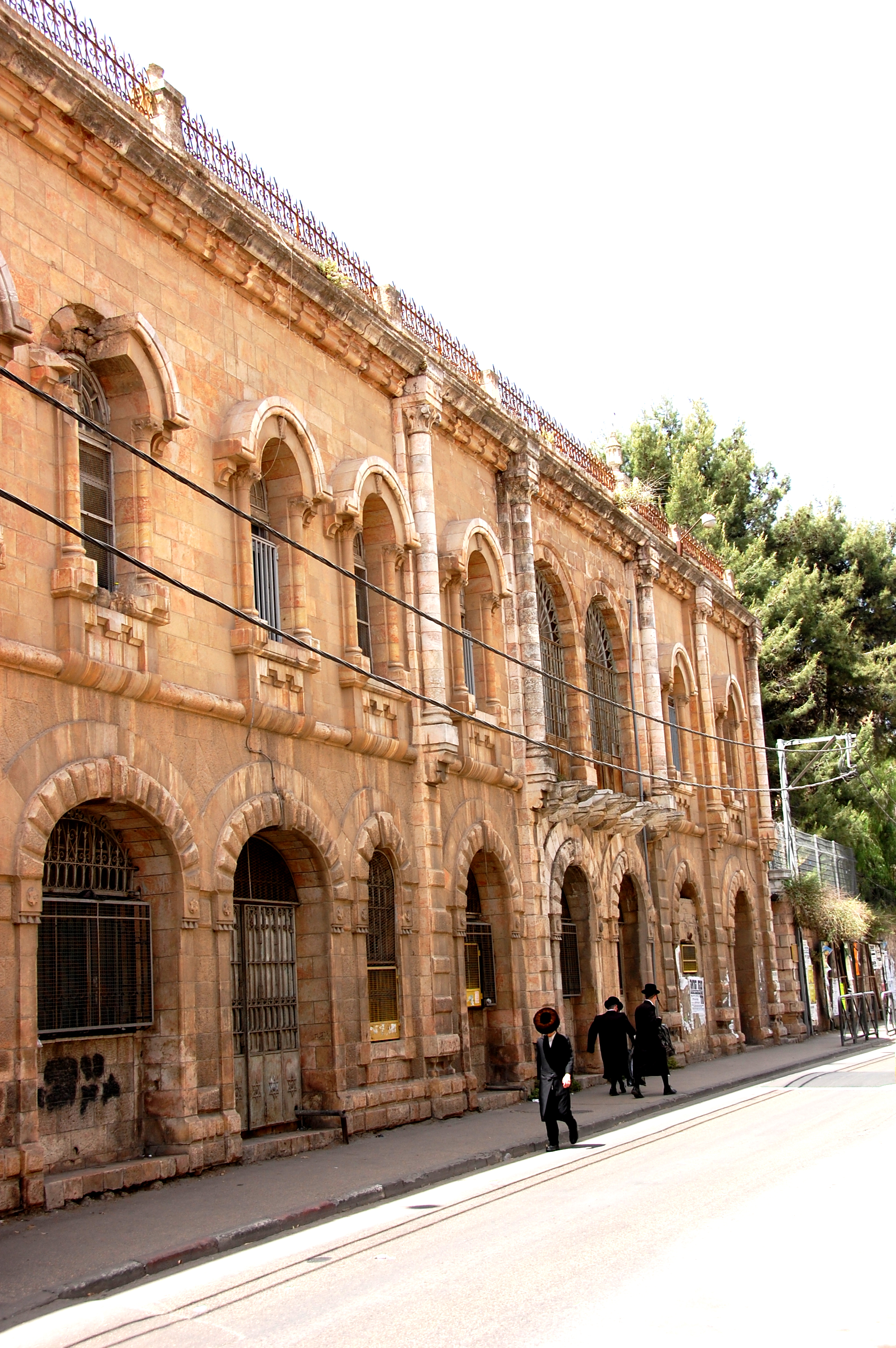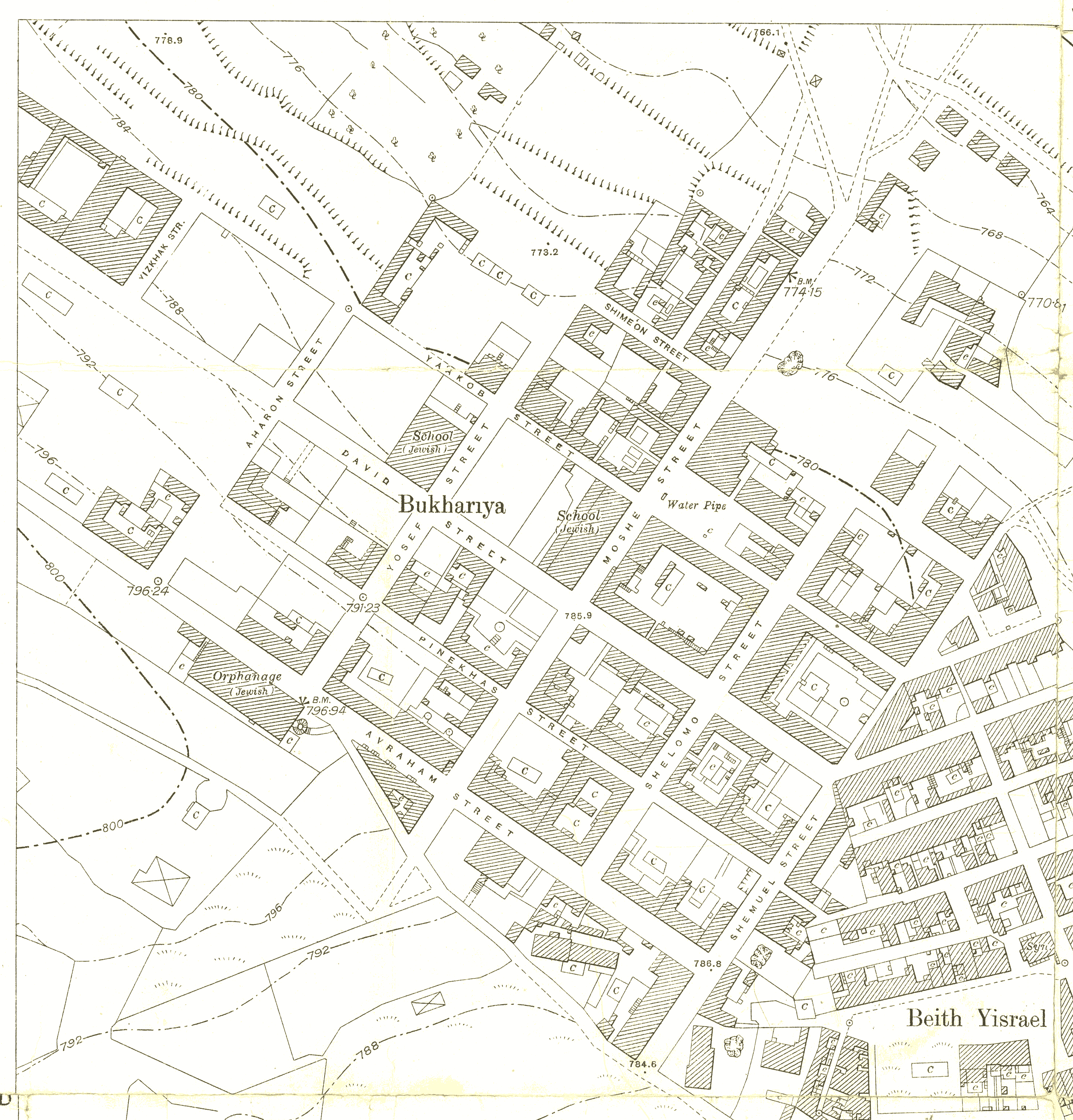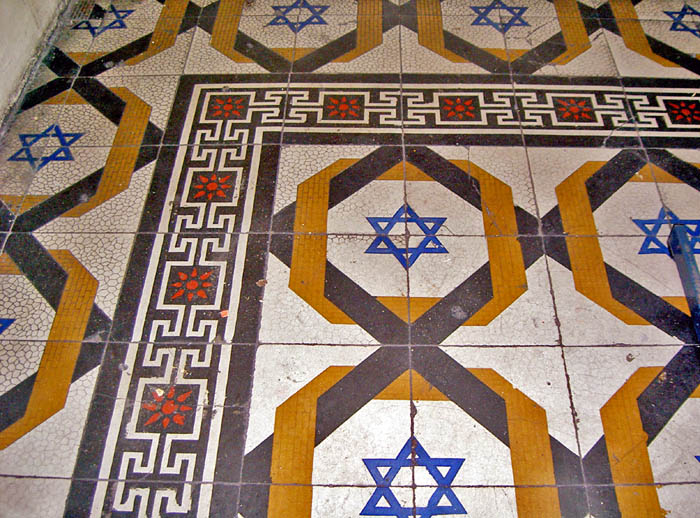Bukharim on:
[Wikipedia]
[Google]
[Amazon]
 The Bukharan Quarter (, ''Shkhunat HaBukharim''), also HaBukharim Quarter or Bukharim Quarter, is a neighborhood in the center of
The Bukharan Quarter (, ''Shkhunat HaBukharim''), also HaBukharim Quarter or Bukharim Quarter, is a neighborhood in the center of
 The first immigrants of
The first immigrants of
''The Jerusalem Post''. 8 January 2009
 Between 1905–1914 Bukharan merchant Elisha Yehudayoff and his son-in-law, Yisrael Haim Hefetz, built the ''Armon'' (lit. "palace") using local limestone and Italian marble with Italian-baroque ornaments. The "Armon" hosted many of the leading figures of the time. During World War I, the Ottoman army had its headquarters there. When the British captured Jerusalem in 1917, a celebratory reception was held in the "Armon". 200 Jewish soldiers serving in the British army attended a
Between 1905–1914 Bukharan merchant Elisha Yehudayoff and his son-in-law, Yisrael Haim Hefetz, built the ''Armon'' (lit. "palace") using local limestone and Italian marble with Italian-baroque ornaments. The "Armon" hosted many of the leading figures of the time. During World War I, the Ottoman army had its headquarters there. When the British captured Jerusalem in 1917, a celebratory reception was held in the "Armon". 200 Jewish soldiers serving in the British army attended a
 The Davidoff House (10, HaBukharim Street) was built in 1906 as an opulent Italian-style mansion for Joseph Davidoff, after the
The Davidoff House (10, HaBukharim Street) was built in 1906 as an opulent Italian-style mansion for Joseph Davidoff, after the
 The Bukharan Quarter (, ''Shkhunat HaBukharim''), also HaBukharim Quarter or Bukharim Quarter, is a neighborhood in the center of
The Bukharan Quarter (, ''Shkhunat HaBukharim''), also HaBukharim Quarter or Bukharim Quarter, is a neighborhood in the center of Jerusalem
Jerusalem is a city in the Southern Levant, on a plateau in the Judaean Mountains between the Mediterranean Sea, Mediterranean and the Dead Sea. It is one of the List of oldest continuously inhabited cities, oldest cities in the world, and ...
, Israel
Israel, officially the State of Israel, is a country in West Asia. It Borders of Israel, shares borders with Lebanon to the north, Syria to the north-east, Jordan to the east, Egypt to the south-west, and the Mediterranean Sea to the west. Isr ...
. The neighborhood was established by Bukharan Jews of the Old Yishuv
The Old Yishuv (, ''haYishuv haYashan'') were the Jewish communities of the Land of Israel during the Ottoman period, up to the onset of Zionist aliyah waves, and the consolidation of the new Yishuv by the end of World War I. Unlike the new Yis ...
. The neighborhood also anchored communities from modern-day Afghanistan and Iran. It belonged to the early Jewish neighborhoods built outside the Old City of Jerusalem as part of a process which began in the 1850s. Today most of the residents are Haredi Jews
Haredi Judaism (, ) is a branch of Orthodox Judaism that is characterized by its strict interpretation of religious sources and its accepted (Jewish law) and traditions, in opposition to more accommodating values and practices. Its members are ...
.
The quarter borders Tel Arza on the west, the Shmuel HaNavi neighborhood on the north, Arzei HaBira on the east, and Geula
Geula ( lit. ''Redemption'') is a neighborhood in the center of Jerusalem, populated mainly by Haredi Judaism, Haredi Jews. Geula is bordered by Zikhron Moshe and Mekor Baruch on the west, the Bukharim neighborhood on the north, Mea Shearim on t ...
on the south.
The current Chief Rabbi of the Bukharan Quarter is Rabbi Shlomo Kassin.
History
 The first immigrants of
The first immigrants of Bukharan Jews
Bukharan Jews, also known as Bukharian Jews, are the Mizrahi Jewish sub-group of Central Asia that dwelt predominantly in what is today Uzbekistan, Tajikistan, Turkmenistan, and Afghanistan. The group's name is derived from the Emirate of Bukh ...
from Russian Turkestan
Russian Turkestan () was a colony of the Russian Empire, located in the western portion of the Central Asian region of Turkestan. Administered as a Krai or Governor-Generalship, it comprised the oasis region to the south of the Kazakh Steppe, b ...
(Central Asia
Central Asia is a region of Asia consisting of Kazakhstan, Kyrgyzstan, Tajikistan, Turkmenistan, and Uzbekistan. The countries as a group are also colloquially referred to as the "-stans" as all have names ending with the Persian language, Pers ...
) settled in Jerusalem in the 1870s and 1880s. In 1890, seven members of the Bukharan Jewish community formed the Hovevei Zion
The Lovers of Zion, also ''Hovevei Zion'' () or ''Hibbat Zion'' (, ), were a variety of proto-Zionist organizations founded in 1881 in response to the anti-Jewish pogroms in the Russian Empire and were officially constituted as a group at a conf ...
Association of the Jewish communities of Bukhara, Samarkand
Samarkand ( ; Uzbek language, Uzbek and Tajik language, Tajik: Самарқанд / Samarqand, ) is a city in southeastern Uzbekistan and among the List of oldest continuously inhabited cities, oldest continuously inhabited cities in Central As ...
and Tashkent
Tashkent (), also known as Toshkent, is the Capital city, capital and List of cities in Uzbekistan, largest city of Uzbekistan. It is the most populous city in Central Asia, with a population of more than 3 million people as of April 1, 2024. I ...
. In 1891, the association bought land and drew up a charter stating that the new quarter would be built in the style of Europe's major cities. Architect Conrad Schick
Conrad Schick (1822–1901) was a German architect, archaeologist and Protestantism, Protestant missionary who settled in Jerusalem in the mid-nineteenth century.Perry & Yodim (2004) For many decades, he was head of the "House of Industry" at the ...
was employed to design the neighborhood. The streets were three times wider than even major thoroughfares in Jerusalem at the time, and spacious mansions were built with large courtyards. The homes were designed with neo-Gothic
Gothic Revival (also referred to as Victorian Gothic or neo-Gothic) is an architectural movement that after a gradual build-up beginning in the second half of the 17th century became a widespread movement in the first half of the 19th century ...
windows, European tiled roofs, neo-Moorish
Moorish Revival or Neo-Moorish is one of the exotic revival architectural styles that were adopted by architects of Europe and the Americas in the wake of Romanticist Orientalism. It reached the height of its popularity after the mid-19th centu ...
arches and Italian marble. Facades were decorated with Jewish motifs such as the Star of David
The Star of David (, , ) is a symbol generally recognized as representing both Jewish identity and Judaism. Its shape is that of a hexagram: the compound of two equilateral triangles.
A derivation of the Seal of Solomon was used for decora ...
and Hebrew inscriptions.
The founders named their settlement Rehovot based on a verse from the Hebrew Bible
The Hebrew Bible or Tanakh (;"Tanach"
. '' Isaac Isaac ( ; ; ; ; ; ) is one of the three patriarchs (Bible), patriarchs of the Israelites and an important figure in the Abrahamic religions, including Judaism, Christianity, Islam, and the Baháʼí Faith. Isaac first appears in the Torah, in wh ...
) called it Rehoboth . '' Isaac Isaac ( ; ; ; ; ; ) is one of the three patriarchs (Bible), patriarchs of the Israelites and an important figure in the Abrahamic religions, including Judaism, Christianity, Islam, and the Baháʼí Faith. Isaac first appears in the Torah, in wh ...
hat is Broad places or Room
A hat is a head covering which is worn for various reasons, including protection against weather conditions, ceremonial reasons such as university graduation, religious reasons, safety, or as a fashion accessory. Hats which incorporate mechan ...
saying, "Now the Lord has made room for us, and we shall be fruitful in the land." (). It became also historically known as Bukhariyeh.
The neighborhood's Baba Tama Synagogue was built in 1894 and named for the Bukharan Jew who financed it.
In 1905-1908, a dairy was opened and cotton fields were planted on the outskirts of the neighborhood.(?). Construction of the quarter continued into the early 1950s. A total of 200 houses were built. During World War I
World War I or the First World War (28 July 1914 – 11 November 1918), also known as the Great War, was a World war, global conflict between two coalitions: the Allies of World War I, Allies (or Entente) and the Central Powers. Fighting to ...
, the Ottoman army occupied several buildings and cut down almost all of the trees. In 1920, a factory for weaving Persian carpet
A Persian carpet ( ), Persian rug ( ),Savory, R., ''Carpets'',(Encyclopaedia Iranica); accessed 30 January 2007. or Iranian carpet is a heavy textile made for a wide variety of utilitarian and symbolic purposes and produced in Iran (histo ...
s opened, providing employment for 80 women.
Between 1953-1963, Rabbi Bernard M. Casper was working as Dean for Student Affairs at the Hebrew University of Jerusalem
The Hebrew University of Jerusalem (HUJI; ) is an Israeli public university, public research university based in Jerusalem. Co-founded by Albert Einstein and Chaim Weizmann in July 1918, the public university officially opened on 1 April 1925. ...
, and during this period he became deeply concerned about the impoverished Quarter. After his appointment as Chief Rabbi
Chief Rabbi () is a title given in several countries to the recognized religious leader of that country's Jewish community, or to a rabbinic leader appointed by the local secular authorities. Since 1911, through a capitulation by Ben-Zion Meir ...
in South Africa
South Africa, officially the Republic of South Africa (RSA), is the Southern Africa, southernmost country in Africa. Its Provinces of South Africa, nine provinces are bounded to the south by of coastline that stretches along the Atlantic O ...
he set up a special fund for the Quarter's improvement and this was tied with Prime Minister Menachem Begin
Menachem Begin ( ''Menaḥem Begin'', ; (Polish documents, 1931–1937); ; 16 August 1913 – 9 March 1992) was an Israeli politician, founder of both Herut and Likud and the prime minister of Israel.
Before the creation of the state of Isra ...
's urban revitalization program, Project Renewal. Johannesburg
Johannesburg ( , , ; Zulu language, Zulu and Xhosa language, Xhosa: eGoli ) (colloquially known as Jozi, Joburg, Jo'burg or "The City of Gold") is the most populous city in South Africa. With 5,538,596 people in the City of Johannesburg alon ...
was twinned with the Bukharan Quarter, and Johannesburg Jewry raised enormous funds for its rehabilitation. Frustrated by the lack of progress, Casper traveled to Jerusalem in 1981 to resolve the hurdles. He consulted with community organizer Moshe Kahan and suggested that they present the dormant agencies with concrete evidence of what could be done. Using a private discretionary fund, he initiated development of several pilot projects, among them a free loan fund, a dental clinic and a hearing center whose successes spurred the municipality back on track.Grace under fire''The Jerusalem Post''. 8 January 2009
Landmarks
Yehudayoff Palace ("Armon")
 Between 1905–1914 Bukharan merchant Elisha Yehudayoff and his son-in-law, Yisrael Haim Hefetz, built the ''Armon'' (lit. "palace") using local limestone and Italian marble with Italian-baroque ornaments. The "Armon" hosted many of the leading figures of the time. During World War I, the Ottoman army had its headquarters there. When the British captured Jerusalem in 1917, a celebratory reception was held in the "Armon". 200 Jewish soldiers serving in the British army attended a
Between 1905–1914 Bukharan merchant Elisha Yehudayoff and his son-in-law, Yisrael Haim Hefetz, built the ''Armon'' (lit. "palace") using local limestone and Italian marble with Italian-baroque ornaments. The "Armon" hosted many of the leading figures of the time. During World War I, the Ottoman army had its headquarters there. When the British captured Jerusalem in 1917, a celebratory reception was held in the "Armon". 200 Jewish soldiers serving in the British army attended a Passover Seder
The Passover Seder is a ritual feast at the beginning of the Jewish holidays, Jewish holiday of Passover. It is conducted throughout the world on the eve of the 15th day of Nisan in the Hebrew calendar (i.e., at the start of the 15th; a Hebrew d ...
there. In 1921, the founding convention of the Chief Rabbinate
Chief Rabbi () is a title given in several countries to the recognized religious leader of that country's Jewish community, or to a rabbinic leader appointed by the local secular authorities. Since 1911, through a capitulation by Ben-Zion Meir ...
took place at the "Armon", at which Rabbis Abraham Isaac Kook
Abraham Isaac HaCohen Kook (; 7 September 1865 – 1 September 1935), known as HaRav Kook, and also known by the Hebrew-language acronym Hara'ayah (), was an Orthodox Judaism, Orthodox rabbi, and the first Ashkenazi Jews, Ashkenazi Chief Rabbina ...
and Jacob Meir were elected. At the end of the British Mandate the "Armon" served as a meeting place for the Irgun
The Irgun (), officially the National Military Organization in the Land of Israel, often abbreviated as Etzel or IZL (), was a Zionist paramilitary organization that operated in Mandatory Palestine between 1931 and 1948. It was an offshoot of th ...
.
Davidoff House
Great War
World War I or the First World War (28 July 1914 – 11 November 1918), also known as the Great War, was a World war, global conflict between two coalitions: the Allies of World War I, Allies (or Entente) and the Central Powers. Fighting to ...
it became for a decade (1915–25) the home of the Hebrew Gymnasium in Jerusalem, a high school which had been founded in the neighborhood in 1909, and it currently serves as the quarter's community center.
Notable residents
*Yitzhak Ben-Zvi
Yitzhak Ben-Zvi ( ''Yitshak Ben-Tsvi''; 24 November 188423 April 1963; born Izaak Shimshelevich) was a historian, ethnologist, Labor Zionism, Labor Zionist leader and the longest-serving president of Israel. He was 1952 Israeli presidential elec ...
(1884–1963), historian, Labor Zionist leader, President of Israel
*Joseph Klausner
Joseph Gedaliah Klausner (; 20 August 1874 – 27 October 1958), was a Lithuanian-born Israeli historian and professor of Hebrew literature. He was the chief redactor of the '' Encyclopedia Hebraica''. He was a candidate for president in the ...
(1874–1958), historian and professor of Hebrew literature
*Dorrit Moussaieff
Dorrit Moussaieff (; born 12 January 1950) is an Israeli jewellery designer, editor, and businesswoman who was the First Lady of Iceland from 2003 to 2016. Born in Israel, she was raised in the United Kingdom from the age of 13.
Biography
Dor ...
(born 1950), Israeli jewellery designer, former First Lady of Iceland
* Shlomo Moussaieff (1852–1922), rabbi, gemstone trader, one of the neighborhood's founders
*Moshe Sharett
Moshe Sharett (; born Moshe Chertok (); 15 October 1894 – 7 July 1965) was the second prime minister of Israel and the country’s first foreign minister. He signed the Israeli Declaration of Independence and was a principal negotiator in th ...
(1894–1965), Labor Zionist leader, Prime Minister of Israel
*Rachel Yanait
Rachel Yanait Ben-Zvi (; May 1886 – 16 November 1979) was an Israeli author and educator, and a leading Labor Zionist. Ben-Zvi was the wife of the second President of Israel, Yitzhak Ben-Zvi.
Biography
Rachel Yanait was born Golda Lishansky in ...
(1886–1979), educator, leading Labor Zionist, wife of Yitzhak Ben-Zvi
* Yitzhak Kaduri (c. 1898-2006), Israeli Kabbalist.
*Avraham Chaim Naeh
Avraham Chaim Naeh (; 3 May 1890 – 21 July 1954) was a Lubavitcher Hasid and major ''posek'' (halachic authority) active during the first half of twentieth century. He is most famous for his works ''Ketzos ha-Shulchan'', ''Piskei HaSiddur'', '' ...
(1890-1954) - Posek
In Jewish law, a ''posek'' ( , pl. ''poskim'', ) is a legal scholar who determines the application of ''halakha'', the Jewish religious laws derived from the written and Oral Torah, in cases of Jewish law where previous authorities are incon ...
.
*Yaakov Chaim Sofer
Yaakov Chaim Sofer (; 1870-1939) was a Sephardic rabbi, kabbalist, talmudist and poseq. He is the author of ''Kaf Hakhaim'', a work of halakha.
Biography
Sofer was born in Baghdad, Ottoman Iraq. He studied the Torah under Abdallah Somekh an ...
(1870-1939) - Sephardic rabbi.
* Reuven Elbaz (1944-) - Sephardic rabbi.
*Yitzhak Goldknopf
Yitzhak Issachar Goldknopf (; born 30 October 1950) is an Israeli politician who serves as the leader of Agudat Yisrael and as the leader of the United Torah Judaism party, following the resignation of Yaakov Litzman. He also serves as a member ...
(1950-) - Israeli politician.
See also
* Batei Saidoff, a house built in 1911 by Y. Saidoff, a Bukharan Jew, outside the Bukharan Quarter * Bukharan Jews in Israel *Expansion of Jerusalem in the 19th century
The expansion of Jerusalem outside of the Old City (Jerusalem), Old City walls, which included shifting the city center to the new neighborhoods, started in the mid-19th century and by the early 20th century had entirely transformed the city. Prio ...
*History of Jerusalem
Jerusalem is one of the world's oldest cities, with a history spanning over 5,000 years. Its origins trace back to around 3000 BCE, with the first settlement near the Gihon Spring. The city is first mentioned in Egyptian execration texts arou ...
Notes
References
{{Coord, 31, 47, 35, N, 35, 13, 8, E, display=title Neighbourhoods of Jerusalem Orthodox Jewish communities in Jerusalem Bukharan-Jewish culture in Israel Quarters (urban subdivision) 1891 establishments in the Ottoman Empire Populated places established in 1891